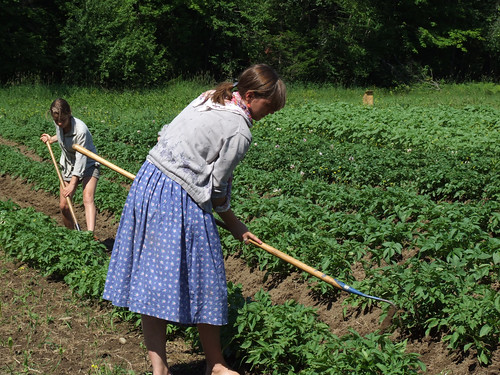What are differences between Jack London and Ernest Hemingway?

Image by Sterling College
Sterling College Gardens – Students hilling potatos.
Question by linda: What are differences between Jack London and Ernest Hemingway?
I know Ernest Hemingway was a very manly man and was very masculine which reflected on his lifestyle, opinions and writing.
Give your answer to this question below!

In my school district: one grade level. (“Call Of The Wild” was read in 7th grade, “Old Man & The Sea” was read in 8th grade.)
thedamnmushroom
January 27, 2014 at 2:33 am
Both were manly. Jack London was incredibly attractive – and so was Ernest Hemingway, although Jack is more my type.
Ernest is the son of a doctor and a musician, with a well-established upper middle class life in Oak Park, Illinois – a fairly well-off suburb of Chicago. Ernest consciously cultivates literary acquaintances and hanging out in bars. He has a non-combatant role in World War I (with the Red Cross, as an ambulance driver), but is within the zone of combat and is injured in a traffic accident. He goes on an expedition to Africa, but gets sick and can’t participate, while his wife and his guide cavort about on the slopes of Kilimanjaro. He is able to hang out in Paris and drink coffee and go to bars, and hang out with James Joyce and everyone else of literary or artistic importance at that time. He has lots of accidents in planes and cars, begins to drink more and more. Several people in his broader family committed suicide. He married several times and broke a few hearts. He had recently come back from Cuba, where he became great friends with Fidel, when he became depressed over money, the IRS, life in general, and shot himself (at the age of 62). He may have had a blood disease at the time as well, something that had killed his father.
Jack is what used to be called a man’s man. A true outdoors-man and nature lover, he was born in San Francisco, to a single mother who was a channeler and a psychic. It’s possible his dad was an astrologer, no one knows for sure as his birth records were destroyed in the Great Fire in SF in 1906. His mother gave him over to the care of a former slave, a woman who was like family for the rest of his life. At the age of 9, Jack read his first novel (a VIctorian romance) and was hooked on going to the library and reading. He started working when he was only 12 years old – 12-18 hour days in SF’s canneries. At 17, he signed up as a sailor and headed out for Japan, working his way across the Pacific. When he returned, the nation was in a fairly big depression and became a tramp (with some odd jobs at hard work – like the steel industry). He got arrested for vagrancy (being a tramp) and it was while he was in jail that he started to write. After that, he committed himself to completing high school. At 21, he heard of the Gold Rush in Alaska and went off in search of riches. He began to sell short stories of adventure to magazines. While he didn’t get to go to Paris, he joined SF’s literary social world, meeting the likes of John Muir. After a brief failed marriage, Jack found his soul mate and made enough money in writing to buy a 1000 acre ranch, which he ran. He was a pioneer in the notion of sustainable agriculture and studied Japanese techniques, hoping to learn how to use a much smaller ecological footprint in farming. It’s not clear that he was successful at ranch management, as he had to travel to promote his books. He, like Hemingway, struggled with alcohol. He traveled out of adventure, too (like Hemingway). He visited Hawaii and met The Duke and Queen Lili’uokalani. He suffered from kidney stones, eventual kidney disease and his death certificate says he died of uremic poisoning (kidney disease) at the age of 40. There’s long been a rumor that he overdosed on morphine, prescribed for the pain of the kidney disease. As a writer, he wrote less about the process of writing than Hemingway and was much less admired during this lifetime, while Hemingway was…Hemingway. London was known to have purchased some of his plots from Sinclair Lewis and admitted to writing primarily for a commercial audience. He used current events in his writing, sometimes using other people’s journalistic prose.
Pili Koa
January 27, 2014 at 2:53 am